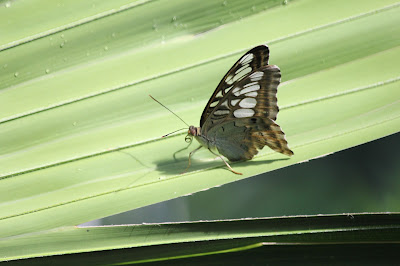It's been three weeks since I have posted any photos from my trail cameras. About 10 days ago I placed both cameras out in one of the local parks along wildlife trails. Yesterday I went out and switched out the memory cards for the cameras (while leaving the cameras in place).
Camera #1
This camera is located in the same place as
my first set of images from late January. I already knew from the first set of pictures that a lot of wildlife uses this area and hoped to get some good pictures. The camera is just far enough from the trail that animals don't seem to be bother by it, although I did have a opossum or raccoon check it out at night from close range. Species diversity was about the same as the first set of pics.
Virginia Opossums (
Didelphus virginiana) showed up several different nights. One night a pair showed up on the camera together.
Northern Raccoon (Procyon lotor) also showed up on the camera several times...
As did several leaping squirrels.
White-tailed Deer (Odocoileus virginianus) showed up every day on the camera, either as individuals or in small groups. The most to appear on the camera at one time was six deer.
I did have one new species show up on this camera. This species was one that I was hoping to get images of and I was not disappointed. What is this mystery species?
It's the
Wild Turkey (
Meleagris gallopavo) of course! I have seen numerous turkeys in this park but have never been close enough to get a clear photograph. This is where trail cameras are awesome! I had turkeys show up several times.
A lone tom showed up once...
So did a pair of toms...
And a flock of hens and last year's chicks. A young male would be known as a jake, and (I just learned this) a young female is a jenny.
Camera #2
My second camera was placed along a trail about 50 yards from the first camera. While it is possible that an animal might show up on one camera and then appear on the other camera a short time later, it is more likely that each camera will record distinct animals as the cameras are set along parallel trails.
The first camera is set up to record pictures in three shot bursts (spaced one second apart). This second camera does not have that option and only records on image at a time. Therefore, there were a lot less pictures on this camera
This camera recorded many of the same species as the other camera.
Northern Raccoons appeared on two separate nights; one night as an individual and another night as a pair.
A couple of squirrels showed up on this camera too...
As did several deer...
Including one small buck that is still holding on to its antlers.
For me the best image captured on this camera was the first one it recorded. That's a
Pileated Woodpecker (
Dryocopus pileatus) in the picture below. I don't necessarily have a favorite
bird, but if I did the Pileated Woodpecker would be in the running. I
get excited every time I see one. A close encounter with a Pileated
Woodpecker is
one of my all-time favorite bird sightings.
The cameras are still in place. Who knows what will show up on them the next time I check...


























































